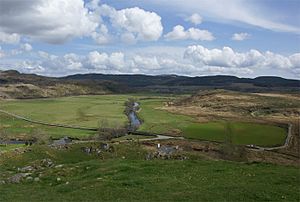Kilmartin Glen facts for kids

Kilmartin Glen is a special area in Argyll, Scotland. It's famous for having the most important collection of ancient sites from the Neolithic (New Stone Age) and Bronze Age periods in mainland Scotland. Imagine a place where people lived thousands of years ago, leaving behind amazing clues about their lives!
Contents
Exploring Kilmartin Glen's Ancient Secrets
Kilmartin Glen is located between the towns of Oban and Lochgilphead, with the small village of Kilmartin at its heart. If you visit, the Kilmartin Museum in the village is a great place to start. It helps you understand the stories of this ancient landscape and the people who lived here long ago.
There are over 800 ancient monuments packed into a small area around the village. About 150 of these are from prehistoric times, meaning they were built before written history began. These monuments include tall standing stones, special circular areas called henges, many stone burial boxes called cists, and a "linear cemetery" which is a line of five burial mounds called cairns. Many of these stones, and even some natural rocks, are decorated with mysterious cup and ring marks.
To the south of the glen, you can find the remains of Dunadd fortress. This was once a royal center for the ancient kingdom of Dal Riata. It sits on the edge of a large bog called the Moine Mhòr, or Great Moss.
The Ancient Burial Line: Kilmartin's Linear Cemetery
One of the most impressive features of Kilmartin Glen is a long line of burial mounds, or cairns. This line stretches for over three miles, heading south from Kilmartin village. Today, there are five main cairns you can see, but clues like cropmarks suggest there might have been even more in the past. Most of these burial cairns were built during the Bronze Age. However, the Nether Largie South cairn is much older, originally from the Stone Age, and was later rebuilt in the Bronze Age.
Glebe Cairn: A Northern Discovery
The Glebe Cairn is the most northern cairn in the line, right next to Kilmartin Village. When it was dug up in 1864, archaeologists found two stone circles hidden beneath the stones. In the very center, they discovered two stone burial boxes (cists). Inside, they found cool items like a jet necklace and a decorated bowl.
Nether Largie North Cairn
This cairn is another important part of the linear cemetery.
Nether Largie Mid Cairn: Roadbuilding and Carvings
The Nether Largie Mid Cairn was first explored in 1929. Sadly, a lot of its stones had been taken to build roads before then. It's about 30 meters wide and used to be 3 meters tall. You can still see the kerbstones that marked its edge. Inside, two cists were found with special grooved joints between their stone slabs. Look closely, and you might spot cup marks and even a carving of an axehead on the southern cist!
Nether Largie South Cairn: The Oldest Monument
Nether Largie South is the oldest monument in this ancient burial line. It's a chambered cairn from the Neolithic period, probably built around 4,000 BC. This type of cairn is known as a Clyde type. It was likely much bigger originally, about 40 meters wide and 4 meters high, but some stones have been removed over time. Inside, there's a long chamber, over 6 meters long, divided into four sections by stone slabs. Even though the chamber is now open, it would have been completely covered by the cairn. Two more cists were also found here. Archaeologists found Neolithic pottery and arrowheads inside Nether Largie South.
Ri Cruin Cairn: A King's Burial Place?
Ri Cruin Cairn is the most southern cairn in the linear cemetery. Local stories say it might be the burial place of a king! It was built between 2200 BC and 1950 BC. More recently, it was even used as a lime kiln. Several excavations have taken place here, helping us learn more about its past.
Mysterious Standing Stones
Tall, single stones standing upright are called menhirs. Kilmartin Glen has several groups of these mysterious stones.
Ballymeanoch Stones
This site has several impressive standing stones.
Temple Wood Stone Circle
Temple Wood features a stone circle, a common type of ancient monument.
Nether Largie Standing Stones: An Ancient Observatory?
The Nether Largie standing stones are located southeast of Temple Wood. They are made up of four large stones arranged in pairs, about 70 meters apart, with one single stone in the middle. Around this central stone are seven smaller stones and one that has fallen over. Another stone stands about a hundred meters to the northwest, pointing towards the stone circle.
Some researchers, like Alexander Thom, believed these stones might have been used as an ancient lunar observatory to predict things like eclipses. He thought it was one of the most important ancient sites in Britain because of the information it seemed to provide. However, other experts have looked at this idea and have reasons to doubt it. They suggest that the stones might not have been deliberately lined up with specific events in the sky.
Cup and Ring Marks: Ancient Art
Kilmartin Glen is home to an amazing number of cup and ring marks. These are mysterious designs carved into natural rock surfaces. They look like small hollows (cups) surrounded by one or more rings. We don't know for sure why people made them or exactly when, but they are very old. You can find these fascinating carvings at places like Achnabreck, Cairnbaan, Ballygowan, and Baluachraig near Kilmichael Glassary.
Kilmartin Glen in Culture
In 2007, Kilmartin Glen was the setting for a special art and performance event called Half Life. This was created by a Scottish theatre company called NVA along with the National Theatre of Scotland. It shows how this ancient landscape continues to inspire people today!



